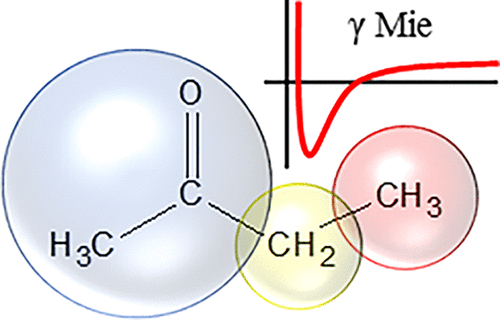当前位置:
X-MOL 学术
›
Ind. Eng. Chem. Res.
›
论文详情
Our official English website, www.x-mol.net, welcomes your
feedback! (Note: you will need to create a separate account there.)
Expanding SAFT-γ Mie’s Application to Dipolar Species: 2-Ketones, 3-Ketones, and Propanoate Esters
Industrial & Engineering Chemistry Research ( IF 3.8 ) Pub Date : 2020-03-19 , DOI: 10.1021/acs.iecr.0c00220 Ruan M. Hurter 1 , Jamie T. Cripwell 1 , Andries J. Burger 1
Industrial & Engineering Chemistry Research ( IF 3.8 ) Pub Date : 2020-03-19 , DOI: 10.1021/acs.iecr.0c00220 Ruan M. Hurter 1 , Jamie T. Cripwell 1 , Andries J. Burger 1
Affiliation

|
Statistical associating fluid theory (SAFT) equations of state (EoSs) are powerful thermodynamic modeling tools that show promise in application to a wide range of different properties and systems. SAFT-γ Mie, the group-contribution variant of the state-of-the-art SAFT-VR Mie, can describe new systems using transferable functional-group parameters. There had been a void in the modeling of nonself-associating dipolar species prior to this work, in which groups were parametrized for 2-ketones, 3-ketones, and n-alkyl propanoates (viz. CH2CO, CH3CO, and COOpr., respectively). These components occur in a wide variety of industrial processes and modeling them with SAFT-γ Mie presented the opportunity to evaluate the model’s treatment of dipolar interactions without a fundamental dipolar term in the EoS. Our new groups provide reliable binary mixture phase-equilibrium, excess enthalpy, and speed of sound predictions for all of the considered components, despite the fact that 2-ketone pure-component predictions are slightly less accurate than what is expected from such a complex SAFT model. The latter observation suggests that very precise modeling of smaller, highly dipolar molecules is challenging with a first-order group-contribution model, even in the SAFT-VR Mie-based framework. Binary mixture VLE predictions of ketone + n-alkane and ketone +1-alkanol systems are in good agreement with experimental data, suggesting that the pseudo-association approach used to treat the dipolar interactions of ketones is adequate, and that its nonrigorous nature does not inherently produce an erroneous representation of the balance between different intermolecular interactions. Two successful high-pressure binary system VLE predictions were also generated, which may spur further research into using SAFT-γ Mie and the new dipolar groups for modeling high-pressure systems.
中文翻译:

扩展SAFT-γMie在偶极物种中的应用:2-酮,3-酮和丙酸酯
统计缔合流体理论(SAFT)状态方程(EoSs)是功能强大的热力学建模工具,显示出在各种不同特性和系统中的应用前景。最新的SAFT-VR Mie的组贡献变量SAFT-γMie可以使用可转移的官能团参数描述新系统。在进行这项工作之前,非自缔合偶极物种的建模存在空白,其中对2-酮,3-酮和丙酸正烷基酯(即CH 2 CO,CH 3 CO和COO PR。, 分别)。这些组件出现在各种各样的工业过程中,并使用SAFT-γMie对它们进行建模,从而为评估模型对偶极相互作用的处理提供了机会,而EoS中没有基本的偶极项。我们的新小组为所有考虑的组分提供了可靠的二元混合物相平衡,过量的焓和声音的预测速度,尽管事实上,2-酮纯组分的预测准确度比这种复杂的SAFT预测的准确度稍差模型。后一个观察结果表明,即使在基于SAFT-VR Mie的框架中,使用一阶基团贡献模型对较小的高度偶极分子进行非常精确的建模也具有挑战性。酮+ n的二元混合物VLE预测-烷烃和酮+ 1-烷醇体系与实验数据高度吻合,表明用于处理酮的偶极相互作用的拟缔合方法是足够的,并且其非严格的性质不会固有地产生平衡的错误表示。在不同的分子间相互作用之间。还产生了两个成功的高压二元系统VLE预测,这可能会刺激进一步研究使用SAFT-γMie和新的偶极子组建模高压系统。
更新日期:2020-04-24
中文翻译:

扩展SAFT-γMie在偶极物种中的应用:2-酮,3-酮和丙酸酯
统计缔合流体理论(SAFT)状态方程(EoSs)是功能强大的热力学建模工具,显示出在各种不同特性和系统中的应用前景。最新的SAFT-VR Mie的组贡献变量SAFT-γMie可以使用可转移的官能团参数描述新系统。在进行这项工作之前,非自缔合偶极物种的建模存在空白,其中对2-酮,3-酮和丙酸正烷基酯(即CH 2 CO,CH 3 CO和COO PR。, 分别)。这些组件出现在各种各样的工业过程中,并使用SAFT-γMie对它们进行建模,从而为评估模型对偶极相互作用的处理提供了机会,而EoS中没有基本的偶极项。我们的新小组为所有考虑的组分提供了可靠的二元混合物相平衡,过量的焓和声音的预测速度,尽管事实上,2-酮纯组分的预测准确度比这种复杂的SAFT预测的准确度稍差模型。后一个观察结果表明,即使在基于SAFT-VR Mie的框架中,使用一阶基团贡献模型对较小的高度偶极分子进行非常精确的建模也具有挑战性。酮+ n的二元混合物VLE预测-烷烃和酮+ 1-烷醇体系与实验数据高度吻合,表明用于处理酮的偶极相互作用的拟缔合方法是足够的,并且其非严格的性质不会固有地产生平衡的错误表示。在不同的分子间相互作用之间。还产生了两个成功的高压二元系统VLE预测,这可能会刺激进一步研究使用SAFT-γMie和新的偶极子组建模高压系统。











































 京公网安备 11010802027423号
京公网安备 11010802027423号